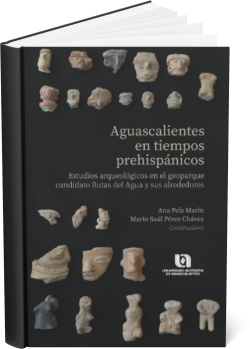AGUASCALIENTES IN PREHISPANIC TIMES: Archaeological studies in the candidate geopark Rutas del Agua and its surrounding area.
Synopsis
Just over three years ago, work began on the application for the Rutas del Agua candidate geopark to obtain the UNESCO Global Geopark designation. These parks are special geographic areas in which sites and landscapes of international geological importance are managed in connection with all other aspects of the natural and cultural heritage of the area. It is a holistic concept of protection, education and sustainable development that promotes a sense of pride and belonging; it stimulates the increase of new ventures, always with a bottom-up approach. Geoparks are a development tool that highlights the inseparable relationship between inhabitants and their environment (Canet and García, 2021). To tell this story and its relationship with water, 14 geosites were chosen, six of geological importance: Cerro de San Juan, Montegrande, Cascada de los Huenchos, Sierra del Laurel, Túnel de Potrerillo and Semifossa de San José de Gracia; Two haciendas, Pabellón de Hidalgo and Garabato, which help us to travel through the viceroyalty; three modern sites to reflect on the present and future of the area: Irrigation District 01, the Calles System and the guava production area of Calvillo; and three archaeological sites: Santiago, Cerro de en Medio and El Tepozán, which allow us to delve deeper into the pre-Hispanic past of the region, a little-known period that only began to be studied a few years ago in the state and is already producing very interesting results.
A little over a year ago we considered doing an exhibition on archaeology, in collaboration with the Autonomous University of Aguascalientes, to present the progress of the research carried out in the geosites of the candidate geopark with the intention of articulating a more intimate relationship between research, education and dissemination for both the university community and the general public. This was intended to address one of the main objectives of UNESCO, the generation and dissemination of knowledge. This book, which consists of eight articles, is the origin of this book.
In the first, the authors reflect on the landscape that can be observed in the state and in particular the type of vegetation found in Aguascalientes. What was that landscape like before the arrival of the Spanish? What was its environment like? Based on this, they propose a methodology to reconstruct this hypothetical condition and compare it with the current situation. Finally, and derived from the above, they speculate on the conditions in which the pre-Hispanic populations of the region lived.
In the second text, archaeologists Nicolás and Lailson address the Cerro de Santiago geosite; as previously mentioned, it is one of the three archaeological sites proposed for the geopark. In the first section, they contextualize the site in time and space as part of the expansion of the northern border of Mesoamerica. The background of the research project that began in 2004 is then presented. Later, the settlement is described, as are the possible interactions that may have taken place in the region, and a first analysis of the lithic industry in the area is made, that is, of the rock-based remains found in the area.
In the third article, archaeologist Manuel Dueñas presents the progress of the archaeological work carried out since 2012 in Cerro de en Medio. These tasks include field trips, cartographic surveys and excavations that have uncovered more than 200 structures such as patios, houses, altars and silos, as well as countless artifacts that are currently being studied. It includes a description of some of the housing units found in the settlement and an analysis of some factors that characterize them, and then comments on daily life in the place. Two construction systems found at the site are presented, as well as the results of chemical analyses of the floor of a room. Finally, some of the lithic and ceramic materials found at the site are described.
In the fourth text, archaeologist Ana Pelz Marín presents a general overview of the region, and then delves into the description of the work carried out at the El Ocote site. The article mentions its location, the excavation work, the findings, the diagnostic materials, burials, a detailed description of the construction systems and the ornamental objects made of rock, clay, shell and bone found in the area. In the next section, archaeologist Miriam Campos Martínez presents some of the results of the work carried out at the La Montesita site between 2012 and 2016, focusing on specific aspects of domestic life, such as the preparation and consumption of food, the storage of products and the work carried out by its inhabitants when they were at home, as well as the production of tools. All this through the description and study of the so-called Unit 2, a space made up of two rooms and a patio, the archaeological materials recovered in the excavations and the chemical analysis of the occupation floors.
In the sixth chapter, archaeologist Jorge Luis Jiménez Meza recognizes the importance of studying ceramics and everything related to its production, and then moves on to pre-Hispanic pottery from Aguascalientes. He comments on the most outstanding studies carried out to date and on some of the elements found: pots, bowls, glasses, human and animal figurines, ear ornaments, yews, plaques or tablets, beads, spheres, seals, snails, pipes and spindle whorls.
In the penultimate article, biologist Karime Pérez Ríos addresses the topic of pre-Hispanic fauna and its use, a work carried out with materials from El Ocote, but which may be a very probable indication of what was happening in the region given the similarities that characterize the area. What animals were hunted or collected in the region during the Epiclassic? How were they used by the inhabitants of those days? These are two approaches proposed in the text. The article then describes the methodologies used in the research, and finally provides the results through which we can learn about the vertebrates and mollusks that were collected in the excavations, learn about their use as food, as well as for the elaboration of multiple objects and tools used for different purposes.
In the last text, historian Mario Arturo Palacios Díaz develops the topic of the graphic rock art heritage of Aguascalientes. He writes about the background of rock art studies and their characteristics in the state and makes a brief description of the findings made in 12 places, which include a geosite and three spaces that are located in the candidate geopark Rutas del Agua.
The articles present maps, photos and reconstructions of the sites and the materials described. We believe that together this work allows us a first look at the Epiclassic in Aguascalientes, particularly at the way in which the communities of those days related to their environment. It is an invitation to learn about and conserve our natural and cultural heritage, inside and outside the Rutas del Agua geopark. Aguascalientes' nomination as a possible geopark of the UNESCO World Geoparks Network has been a turning point in rethinking the way we view our heritage. We hope that this is only one of the first products of this more comprehensive, more collective, more committed view of the land.
Chapters
-
INTRODUCTION
-
Original vegetation hypothetical of the region of Aguascalientes
-
Cerro de Santiago
-
The Cerro de en Medio, a pre-Hispanic pre-Hispanic to be discovered
-
El Ocote, a pre-Hispanic pre-Hispanic settlement in the municipality of Aguascalientes
-
La Montesita: domestic life in pre-Hispanic Aguascalientes pre-Hispanic
-
Pre-Hispanic ceramics of Aguascalientes
-
Fauna and its use at the archaeological archaeological site El Ocote
-
Cave graphic graphic heritage of Aguascalientes

Downloads
Published
Series
Categories
License

This work is licensed under a Creative Commons Attribution-ShareAlike 4.0 International License.













